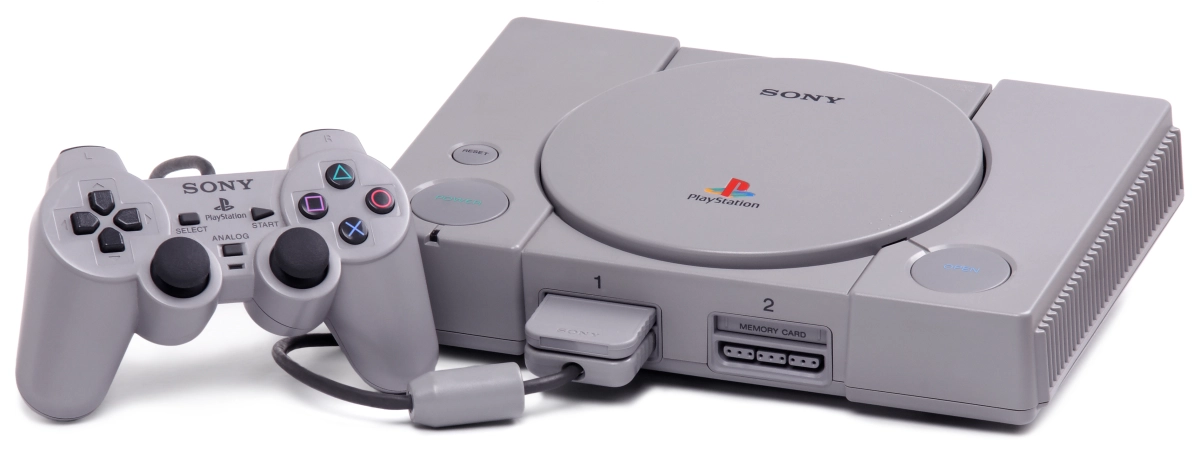Sony PlayStation (1994) marked a significant moment in the history of video games. Released on December 3, 1994, the console was a collaboration between Sony Computer Entertainment and Nintendo. However, when the partnership fell through, Sony decided to launch PlayStation as an independent project. It was an ambitious move that paid off – the console quickly established itself as a major player in the gaming industry and became the first home video game system to sell 100 million units worldwide.
The PlayStation’s success was largely due to its advanced graphics and shift from 2D to 3D games, which revolutionized the gaming experience. With a huge variety of game titles in different genres, including platformers, RPGs, and racing games, the PlayStation brought something new to the gaming table. Its massive success led to the creation of several more versions of the console and paved the way for the future of gaming. As we delve into the fascinating history of Sony PlayStation, we’ll explore both the success of the platform and its significance in the gaming industry.
History of Sony PlayStation
Sony made its foray into the video game industry in 1994, with the debut of the original PlayStation. The development and launch of the console was a significant milestone in Sony’s history, as it marked the company’s first venture into the gaming space. The PlayStation was initially intended to be a joint project with Nintendo, but the partnership ultimately fell apart because of disagreements over licensing and proprietary technologies.
Despite this setback, Sony persevered and went ahead to launch the PlayStation in December 1994 in Japan, followed by North America and Europe in 1995. The console quickly achieved massive success and critical reception. Players were thrilled with its sleek design, user-friendly interface, and the immense power it had to create 3D graphics, previously unseen in video games.
The release of Sony PlayStation was a watershed moment in the gaming industry as it led to the domination of the CD-ROM format over cartridges. It also introduced a new way of gaming where people would sit in front of the TV, and engage with interactive entertainment for hours on end.
The console quickly became the best-selling gaming console of its generation, setting the stage for Sony’s continued dominance in the industry. The PlayStation set a high standard for its competitors by creating a gaming console packed with innovative features and technologies such as 3-D graphics acceleration and CD-quality audio that was unprecedented at the time. It became synonymous with the generational shift that took place in the gaming industry, as it cemented the industry’s transition from 2D to 3D games.
Sony made the most of these advancements and technological innovations to create an ecosystem of game titles that caught the imagination of gamers worldwide. The company capitalized on the growing demand for open-world and role-playing games and produced an array of successful titles, including Resident Evil, Final Fantasy, and Metal Gear Solid. These titles paved the way for the PlayStation to become one of the most iconic brands in gaming history.
Reception and Sales of Sony PlayStation
Sony PlayStation was one of the most successful console launches in the history of video games. Released in Japan in December 1994 and in North America the following year, the PlayStation was an instant hit. In the first year alone, the console sold over 10 million units! Here’s how the PlayStation performed sales-wise and what the public thought of it:
Initial sales and market performance
The sales of the PlayStation eclipsed all expectations. At a time when Sega Saturn and Nintendo 64 were already present in the market, Sony PlayStation still managed to sell almost three times as many units as its rivals. Sony benefited from its strong brand equity, having already established themselves as a pioneer in consumer electronics industry with Walkman, Discman, and VCRs in the past. Along with the built-in CD-ROM drive and wider range of software, the PlayStation’s marketing campaign and price point made it a desirable console for most gamers.
Consumer response, reaction, and reviews
The public reaction to Sony PlayStation was overwhelmingly positive. With its sleek, futuristic design and advanced features, it became the go-to platform for gaming enthusiasts. PlayStation’s library of unique and exclusive games, especially the ones from Japan, made fans and critics alike fall in love with the system. Most reviews praised Sony’s commitment to creative freedom for developers, allowing the creation of unique and genre-defining games.
Comparison with rivals such as Sega Saturn and Nintendo 64
In comparison to Sega Saturn and Nintendo 64, Sony PlayStation provided better 3D graphics, smoother performance, and far more versatile technology. There were some notable differences between the consoles – PlayStation used CD-ROMs, while its rivals still relied on cartridges. The CD-ROM format had many advantages, including reduced manufacturing and storage costs, a larger storage capacity, and a wider range of possible content. While Nintendo 64 relied on cartridges, Sony PlayStation’s CD-ROMs format provided better cinematic experiences with lush pre-rendered graphics and soundtracks. The Sega Saturn and Nintendo 64 remained popular, but the PlayStation emerged as the clear winner in the console wars of the mid 1990s.
Games on Sony PlayStation
Sony PlayStation’s impressive variety of games played an important role in the console’s success. The system featured a range of popular and influential game titles, with some of the most iconic being Gran Turismo, Tomb Raider, and Final Fantasy VII.
The PlayStation boasted an impressive array of genres, including platformers, RPGs, racing and sports games, and more. The diversity of titles available attracted a wider range of gamers and helped the console appeal to a broader audience.
The significance of these games to the success and cultural impact of Sony PlayStation should not be overlooked. Certain games on the system, such as “Final Fantasy VII,” became cultural touchstones and have had a lasting impact on the gaming industry. The success of the PlayStation during its initial run helped solidify its place in gaming and pop culture history, and the games played a significant role in achieving that.
Sony PlayStation Review and Retrospective
When Sony first released the PlayStation in 1994, many people in the gaming industry were skeptical about the company’s entry into the competitive console market. However, Sony’s innovative approach, focus on CD-ROM technology, and strong marketing strategy paid off. The PlayStation quickly became a hit and revolutionized the gaming industry in ways that are still felt today.
Factors that made Sony PlayStation a success:
One of the primary factors that made the PlayStation so successful was its innovative use of CD-ROM technology, which allowed for much larger and more complex games than what was possible on previous consoles. Sony also had a fresh and targeted marketing approach, which exposed the console to people who might not traditionally be into gaming. The PlayStation’s ability to play audio CDs in addition to games, along with its affordable price point, further expanded its audience.
Comparing Sony PlayStation to other consoles of its time:
Compared to its competitors, such as the Sega Saturn and the Nintendo 64, the PlayStation had better graphics, superior sound quality, and more significant storage capacity. The ability to save games directly on a memory card was also a significant advantage, rather than having to rely on internal console storage or passwords like other consoles. Sony focused on creating games that targeted different genres, such as sports, racing, and adult-themed games, giving players a diverse selection of games.
Legacy and lasting impact of Sony PlayStation, both on gaming and technology:
The PlayStation made a lasting impact on the gaming industry, changing the way games were developed, played, and marketed. The PlayStation also introduced many people to the gaming world, paving the way for the gaming industry’s mainstream acceptance. Sony PlayStation’s design choices, such as the DualShock controller with its two analog sticks, have also become industry standards and are still used in modern gaming today. Sony’s innovative approach paved the way for future advancements such as online gaming, which has since become a crucial aspect of gaming.
Conclusion: Sony PlayStation and the Future of Gaming
After reflecting on the impact that the Sony PlayStation had on the gaming industry, it is evident that it holds a significant place in the history of video games. With its innovative technology, versatility, and impressive library of games, Sony PlayStation was a console that established itself as a trailblazer in the gaming industry. It introduced a new level of quality and accessibility in gaming that paved the way for even more advancements in technology and gaming experiences.
As we look towards the future of the gaming industry, it is exciting to imagine the possibilities that will be brought about by the latest technologies such as virtual reality and cloud gaming. With these advancements, we can expect even more immersive gaming experiences, optimized performance, and innovative game mechanics that will continue to push the gaming industry to greater heights.
In conclusion, the Sony PlayStation not only holds a special place in video game history but continues to inspire the evolution of gaming as an industry. Its legacy has helped shape the experience that gamers have today and will continue to define the future of gaming as it evolves with the advancements in technology. We are excited to see the continued growth of the gaming industry and look forward to experiencing the new possibilities that will be brought about by new consoles and technology in the future.
FAQs:
1. What was the significance of Sony PlayStation?
As the first gaming console produced by Sony, the PlayStation helped to establish the company as a major player in the gaming industry. With its CD-ROM format, it helped to popularize the use of optical media for video games, and its success encouraged other companies to enter the market.
2. What were some of the popular games on the Sony PlayStation?
Some of the most popular games on the PlayStation included Gran Turismo, Tomb Raider, and Final Fantasy VII. These games helped to establish the console’s reputation for delivering high-quality gaming experiences with immersive storylines and innovative gameplay.
3. How did the Sony PlayStation compare to its rivals, such as Sega Saturn and Nintendo 64?
In terms of sales and market performance, the PlayStation outperformed both the Sega Saturn and the Nintendo 64. Its CD-ROM format, larger game library, and more affordable price point helped it to appeal to a wider audience and establish itself as a dominant force in the gaming industry.
4. What technological innovations set the Sony PlayStation apart from other consoles of its time?
The PlayStation’s use of CD-ROMs, which offered more storage space than cartridges, was a major innovation at the time. It also featured advanced graphics and sound capabilities, including the ability to display 3D graphics, which helped to make games more immersive and engaging.
5. What is the lasting impact of the Sony PlayStation on gaming and technology?
The PlayStation helped to establish several trends that continue to shape the gaming industry today, including the use of optical media, the focus on immersive storylines and innovative gameplay, and the use of advanced graphics and sound technology. Its success also helped to cement Sony’s position as a leader in the technology industry.













